Tree care can be incredibly dangerous, even for professional arborists. Even so, many "do-it-yourself" homeowners attempt their own tree work, often with disastrous results.
In 2015 alone, the Tree Care Industry Association (TCIA) recorded 58 serious civilian tree care accidents, 34 of which were fatal. Six of these victims were under the age of 13, and were innocent bystanders to the misguided actions of adults.
While these numbers are not representative of all tree care accidents involving non-professionals, they provide insight into the types of hazards civilians are likely to encounter while attempting tree work.
What Would the Pros Do?
 “To fully comprehend the dangers of tree work, consider this: No layperson would attempt to pilot a small aircraft without the requisite training and experience. And yet, that is essentially the same risk level one assumes when attempting tree work,” says Peter Gerstenberger, TCIA’s senior advisor for safety, standards, and compliance. “Tons of suspended weight, great heights, powerful equipment and kilovolts of electricity – these are just a few of the hazards encountered in routine tree trimming and removal.”
“To fully comprehend the dangers of tree work, consider this: No layperson would attempt to pilot a small aircraft without the requisite training and experience. And yet, that is essentially the same risk level one assumes when attempting tree work,” says Peter Gerstenberger, TCIA’s senior advisor for safety, standards, and compliance. “Tons of suspended weight, great heights, powerful equipment and kilovolts of electricity – these are just a few of the hazards encountered in routine tree trimming and removal.”
Here are a few examples of typical tree care-related accidents experienced by civilians in 2015, and what a professional arborist might have done to avoid the situation:
Typical Fall
A 66-year-old man fell approximately 15 feet when the branch he cut demolished the ladder he was standing on. The limb landed on top of him. The man was extricated by first responders, and sustained several fractured vertebrae.
What would the pros do? “Arborists rarely work from ladders and when they do, they secure themselves to the tree before cutting branches,” says Gerstenberger. “Arborists use specific cuts to get branches to fall in a very precise way, or they use ropes and/or rigging for controlled lowering. They also rarely work alone, preferring to have at least one trained set of eyes on the ground to spot hazards, or to run the ropes.”
Typical Struck-by
A 78-year-old Bellefontaine, Ohio man was seriously injured while cutting wood alone behind his home. He was listed in critical condition after a large tree fell in an unintended direction, landing on his lower left leg and pinning him. About one hour after the accident, a concerned neighbor discovered the victim and called 911. The victim sustained fractures to both legs and an arm.
What would the pros do? “Arborists typically work in teams to remove a tree safely. Any removal starts with an assessment of the tree and surroundings for hazards. Factors such as tree lean, internal defects, hung-up branches and even wind can completely alter a tree’s trajectory,” says Gerstenberger. “Arborists use directional-felling techniques, a precise series of cuts that create a hinge to guide the tree in the intended direction. They also give the tree a wide berth; arborists involved in the felling stay at least 1 ½ times the tree height away, and uninvolved workers stay twice the tree height away. Finally, arborists typically attach a pull rope high in the tree to help guide it in the intended direction.”
Typical Electrical Contact
In Florida, two men were trimming trees on church property with a rented lift when they came in contact with an overhead power line and were shocked and burned. The accident knocked out power in the nearby community, indicating that the seemingly harmless, bare wire they encountered carried primary distribution voltage — thousands of volts!
What would the pros do? “First of all, arborists recognize electrical conductors to be the most unforgiving of all hazards encountered in the field. Most electrical contact incidents are fatal,” says Gerstenberger. “Arborists who don’t have electrical hazards training stay at least 10 feet away from ALL electrical conductors. They realize that metal ladders and pole tools, tree limbs and various types of equipment can conduct electricity. Unlike the two unfortunate gentlemen at the church, they would never approach a wire in an uninsulated, rental-yard lift. Arborists who work within 10 feet of conductors have special training, use rated insulated equipment and follow special procedures to avoid the electrical hazard.
Hire a Professional
Don’t become a statistic. Hire a professional tree care provider to ensure safe, quality work. Search for qualified tree care in your ZIP Code.